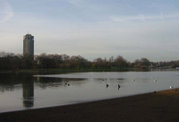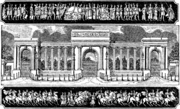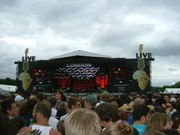Hyde Park, London
2007 Schools Wikipedia Selection. Related subjects: Geography of Great Britain
| Royal Parks of London |
|---|
|
Hyde Park is one of the largest parks in central London and one of the Royal Parks of London. The park is divided in two by the Serpentine Lake. The park is contiguous with Kensington Gardens, which is widely assumed to be part of Hyde Park, but is technically separate. Hyde Park is 350 acres (1.4 km²) and Kensington Gardens is 275 acres (1.1 km²) giving an overall area of 625 acres (2.5 km²).
Hyde Park is also home to the New Zealand World War One memorial.
The park was the site of The Great Exhibition of 1851, for which the Crystal Palace was designed by Joseph Paxton.
The park has become a traditional location for mass demonstrations. The Chartists, the Suffragettes and the Stop The War Coalition have all held protests in the park.
On July 20, 1982 in the Hyde Park and Regents Park bombings, two bombs linked to the IRA caused the death of seven horses and eight members of the Household Cavalry and the Royal Green Jackets.
Grand Entrance
The Grand Entrance to the park, at Hyde Park Corner next to Apsley House, was erected from the designs of Decimus Burton. It consists of a screen of handsome fluted Ionic columns, with three carriage entrance archways, two foot entrances, a lodge, etc. The extent of the whole frontage is about 107 ft (33 m). The central entrance has a bold projection: the entablature is supported by four columns; and the volutes of the capitals of the outside column on each side of the gateway are formed in an angular direction, so as to exhibit two complete faces to view. The two side gateways, in their elevations, present two insulated Ionic columns, flanked by antae. All these entrances are finished by a blocking, the sides of the central one being decorated with a beautiful frieze, representing a naval and military triumphal procession. This frieze was designed by Mr. Henning, junior, the son of Mr. Henning who was well known for his models of the Elgin marbles.
The gates were manufactured by Messrs. Bramah. They are of iron, bronzed, and fixed or hung to the piers by rings of gun-metal. The design consists of a beautiful arrangement of the Greek honeysuckle ornament; the parts being well defined, and the raffles of the leaves brought out in a most extraordinary manner.
Sites of interest
Sites of interest in the park include Speakers' Corner (located in the northeast corner near Marble Arch) and Rotten Row which is the northern boundary of the site of the Crystal Palace. To the southeast is Hyde Park Corner. South of the Serpentine Lake is the Diana, Princess of Wales memorial, an oval stone ring fountain opened on July 6, 2004. A botanical sensation is the bizarre upside-down tree. Opposite Hyde Park corner stands one of the grandest hotels in London, The Lanesborough, which offers its top suite at £6,000 per night.
Stanhope Lodge at Stanhope Gate, demolished to widen Park Lane, was the home of Samuel Parkes who won the Victoria Cross in the Charge of the Light Brigade. Parkes was later Inspector of the Park Constables of the Park and died in the Lodge on 14 November 1864.
The photography for the Beatles album Beatles for Sale was taken at Hyde Park in autumn of 1964.
Concerts
Hyde Park has been the venue for some famous rock concerts, including those featuring Jethro Tull (1968), Blind Faith (1969), The Rolling Stones (1969), King Crimson (1969), Pink Floyd (1970), Roy Harper (1971), The Who (1973), Bon Jovi (2003), Red Hot Chili Peppers (2004), Live 8 (2005), and the Foo Fighters (2006), who played their biggest crowd to date with over 80,000 people in attendance.
Queen played one of their most famous gigs here in 1976. They set an attendance record, with 150,000 people confirmed to be in attendance. The actual number is thought to be closer to 180,000, if not 200,000.
More recent events include Red Hot Chili Peppers, who, at Hyde Park, set a world-wide record for the highest grossing concert at a single venue, in history. It is estimated that 245,000 people saw it over the course of three nights, thus calculating to over 80,000 people per night.
The Irish dance spectacular "Feet of Flames" was made on July 25, 1998 for a one-time event in Hyde Park's the Route of Kings (a riding track called the "Route du Roi" is now always known as "Rotten Row"). In front of an audience of 25,000 people Michael Flatley danced on one of the largest stages ever built, specifically made for the show.
Poem
- At Rotten Row around a tree
- With Albert's help did Mr P
- His stately pleasure dome design:
- The greatest greenhouse ever seen;
- A glass cathedral on the green,
- Beside the crystal Serpentine.
- (from "Joseph and His Amazing Crystal Palace" by John Greatrex, parodying "Kubla Khan" by Samuel Taylor Coleridge)
- With Albert's help did Mr P
Hyde Park in fiction
In Volume II of Alan Moore's graphic novel, The League of Extraordinary Gentlemen, a character implies that Hyde Park is named in honour of Mr. Edward Hyde, the bestial alter ego of Dr. Henry Jekyll, the titular character(s) of Robert Louis Stevenson's novella, The Strange Case of Dr. Jekyll and Mr. Hyde. This was a posthumous honour, done so to recognize Hyde's death while attempting to stop invaders from the planet Mars in their advance upon London (adapted from H. G. Wells' The War of the Worlds). In this story, Hyde Park was originally named "Serpentine Park".
In The Face of Evil (a serial in the British science fiction television series Doctor Who), The Doctor is attempting to reach Hyde Park when he lands on an alien planet.
Hyde Park is also the setting for Anne Perry's Victorian murder mystery, The Hyde Park Headsman in which several murder victims are found beheaded in or near the park under strange circumstances, causing near-hysterical terror in the residents of 1892 London. Superintendent Thomas Pitt is charged with discovering the murderer before he/she can strike again.
Hyde Park features as a setting in The Eye in the Door by British novelist Pat Barker. Chapter one in particular alludes to the Park's history as a gay cruising ground before the decriminalization of homosexuality in 1967.


